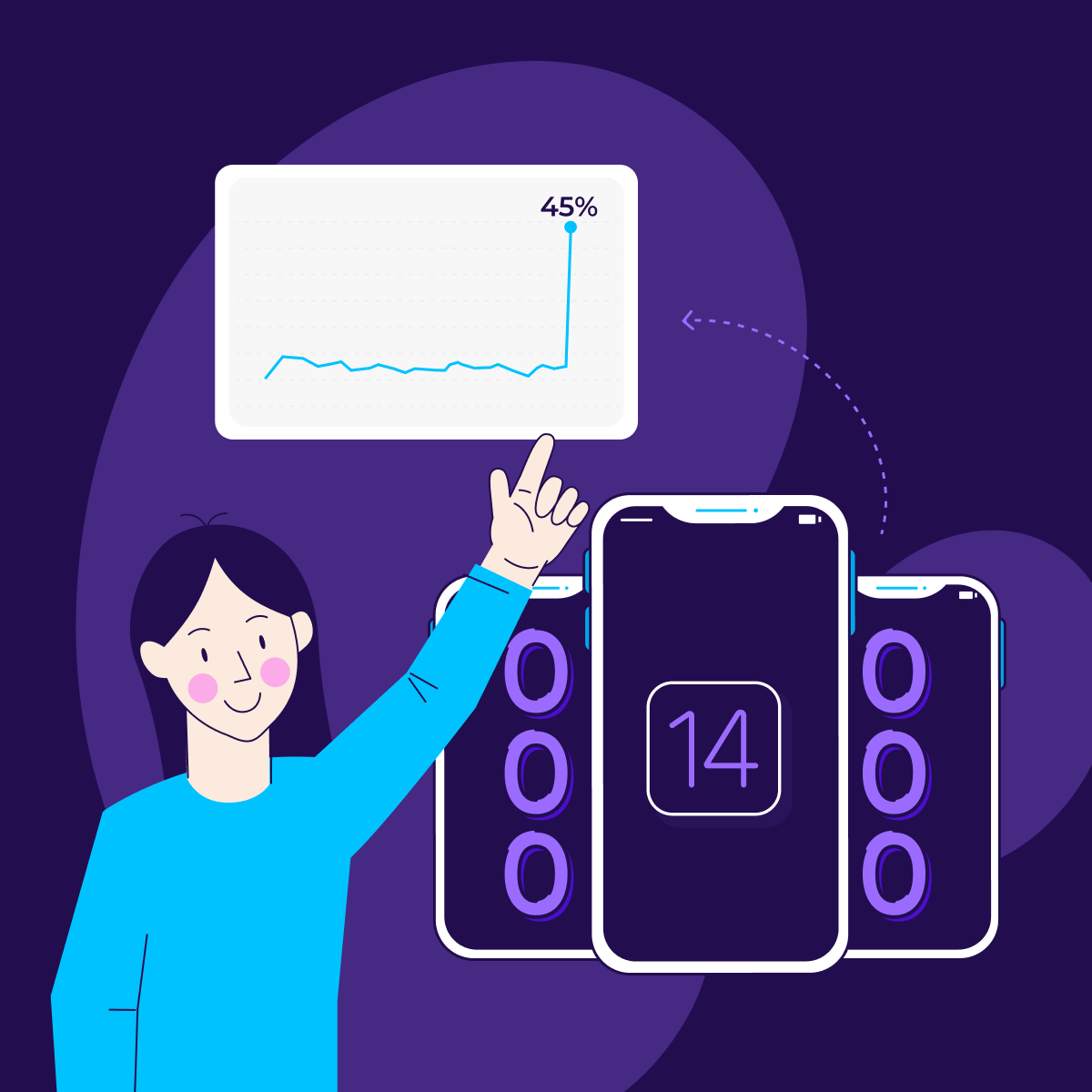
The untold story about zeroed IDFAs on iOS 14 devices

On September 16th of this year, the highly-anticipated iOS 14 was widely-released to the public.
While the industry knew this version was due to come out sometime in September, Apple gave developers less than 24 hours’ notice about the public release date.
Unlike previous years, this year the new iOS was released ahead of the new iPhone models and not simultaneously. As one might expect, this slowed the adoption rate of the new iOS (as the new devices are sold with the new iOS installed). According to our data, iOS 14 surpassed 46% adoption just last week, and this rate is expected to rise dramatically when the new iPhone 12 becomes widely available in November.
Apple announced an abundance of new privacy features when iOS 14 was introduced in June, most notably the new App Tracking Transparency (ATT) framework that was expected to all but diminish IDFA collection.
While the release of this feature was postponed to early 2021, giving developers more time to prepare, a curious phenomenon has occurred: since the public release of iOS 14, the industry has noted a massive surge in iOS devices with zeroed IDFA.
Zeroed IDFAs were introduced with iOS 10 back in 2016, and are the result of the user opting out of ad tracking. Prior to the release of iOS 14, the average worldwide rate of devices with Limit Ad Tracking enabled was around 24%; the US and Europe had the highest prevalence of LAT devices (30% and 18.3%, respectively).
Since the release, the numbers of zeroed-IDFA devices have skyrocketed, and now stand at an astonishing 45% of all iOS 14 devices worldwide.
The aforementioned ATT was designed to replace LAT. Rather than offering iOS users the opportunity to opt-out of sharing their IDFA with advertisers in their device settings, the new AppTrackingTransparency framework (ATT) requires users to actively opt-in to IDFA collection when using the app.
Users that had turned on LAT previously would automatically be converted to ATT-negative users, maintaining their status of sending a zeroed IDFA to advertisers. For this reason, we expected the prevalence of zeroed IDFA devices to stay constant.
Clearly, this is not the case.
So what is happening? And why?
The four horsemen of the IDFA apocalypse
The surge in zeroed-IDFA devices post-iOS 14 release became immediately apparent, causing much confusion and frustration in the industry. After some research and investigation, we have uncovered the cause.
The shift from LAT to ATT didn’t turn out to be a binary “opt-in/opt-out” scenario, as we anticipated it to be.
In reality, the new iOS 14 user has four possible states of existence:
- Not Determined – No ATT dialog was presented to the user, therefore the user made no active choice about sharing their IDFA. This status also includes user devices where LAT was turned on in earlier iOS versions. (IDFA shared/not shared accordingly)
- Denied – The user chose via ATT to not be tracked by the app (IDFA not shared)
- Allowed – The user chose via ATT to allow tracking (IDFA shared)
- Restricted – Access to IDFA sharing is blocked without any end-user input (IDFA not shared).
Due to the delay in deployment of the ATT framework, we expected that most users would fall under the Not Determined status.
We expected roughly 75% of devices to be Not Determined after the public release of iOS 14. In reality, only 62% of devices are now in Not Determined status.
Surprisingly, the sum of Denied and Allowed is around 20%.
While Apple postponed the implementation requirement for ATT to early 2021, some developers went ahead and integrated it in their iOS 14 apps anyway. The ATT framework prompts the user to opt-in to allow tracking when they use the updated app. Unsurprisingly, when prompted, the majority of users (99%) choose not to allow tracking.
The big surprise in these results, however, is the 18% of devices that fall under the Restricted category. These devices send zeroed IDFAs, without the users having made any proactive choice about sharing it whatsoever.
Restricted status: Explained
Let’s address the elephant in the room: why are we seeing an 87.5% increase in zeroed IDFA devices in iOS 14?
The answer lies in the Restricted devices category. This vaguely-defined category creates complexities for the industry, bringing on scenarios that weren’t foreseen.
First, let’s define what Restricted means here.
A Restricted device will report similarly to a LAT-enabled device: the IDFA will be zeroed across all apps.
Users with Restricted devices have reported that the LAT privacy setting (“Allow Apps to Request to Track”) on their devices is grayed out, meaning they cannot change this setting on their own.


What’s more, this setting appears to be open to some manipulation and prone to bugs. Savvy iOS users have reported that they’ve been able to “ungray” the setting, by logging out and back into their iCloud account.


Why would a user be restricted in the first place?
This is a good question, with no official answer to be found. There are some assumptions and partial answers from Apple.
We have collected what we know so far:
- User age
1. The user is under the age of 13, or between the ages of 13-18
2. The user’s age is unknown - Education
1. The device is in Education mode
2. The App Store account was created by an educational institution (known as Managed Apple ID) - Restricted profile
The device has a profile installed with a preset restriction. An example of this would be “MCFeatureLimitAdTrackingForced”. This may be set by an organization for employee devices, for example.
Facing the future, head on
iOS 14 has disrupted the mobile marketing landscape and we expect the pace of disruption to increase as the adoption of iOS 14 grows. That’s why we built a culture of agility and innovation into the heart of our company that allows us to not simply adapt to, but anticipate and plan for, whatever changes lie ahead.
We admit it – this sudden uptick in IDFA-zeroed devices was surprising to us; surprising, but not alarming. It is simply another aspect of the evolving landscape that we are well-equipped to support.
With mobile attribution and measurement becoming ever more complex, we’ve invested in building the largest and most experienced team of developers in the industry to support brands with the measurement tools they need to succeed and make sure they stay competitive in today’s ever-changing market.




